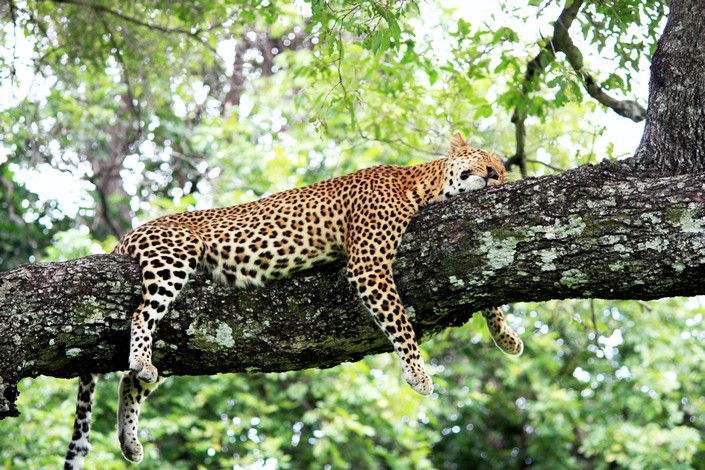Natural beauty in Kenya: Lake Naivasha
A beautiful freshwater lake, Lake Naivasha in Kenya is fringed by thick papyrus. Even though it’s almost 13km across, its waters are shallow with an average depth of only 5m. The size of the actual lake area depends mainly on the rainfall. The size can vary between 114 and 991km². At 1,890 metres above sea level, the Lake is at the tallest point in the Kenyan rift, and is settled in an intricate geological mixture of volcanic rocks and sand deposits from a much bigger Pleistocene era lake.
The history of the lake
At the beginning of the 20th Century, there was practically no lake, as Lake Naivasha completely dried up. Farmers decided to use the open land for farming. But it wasn’t long after that, when a few years later, rain poured down heavily and washed away the newly established estates.
Heavy winds and storms in the afternoons usually produce high waves in the lake. Because of this, the local Masai christened the lake Nai’posha. This means ‘rough water’. The British later misspelled the word as Naivasha.
Aside from fleeting streams, Lake Naivasha is fed by the Malewa and Gilgil rivers, but has no visible outlet. This has resulted in the deduction that the water of the Lake must be forced out through a volcanic fissure or something of that sort, beneath its vast lake bed. It has been suggested that this water then makes its way through the fresh hot water springs in Lake Magadi, an otherwise pink soda lake that lies 120 kilometres to the south.
Floriculture makes up the primary industry surrounding the Lake. However, the unregulated use of lake water for irrigation is reducing the Lake’s levels, which is becoming an issue of concern in Kenya. Other sources of employment and income for the locals come from fishing in the region. When visiting this area, be sure to pay a visit to one of the most beautiful parks in Kenya, Crescent Island Park. Here, you will have the opportunity to observe plenty of birdlife and game such as wildebeest, waterbuck, zebra and giraffe.
Wildlife around the Lake Naivasha
Lake Naivasha and its surroundings have fertile soils and plenty of water supply, making this area one of Kenya’s prime agricultural regions. Many forests surround this lake, drawing an astounding amount of birdlife. Keeping the birds company, are giraffes, buffalo, Colobus monkeys, hippos and many other game. Take a boat trip out on the lake, and try and spot an African Fish Eagle scoop itself a bite to eat.
Big concentrations of hippos typically wander into the surrounding accommodation during the evenings in search of food. As it is a freshwater lake, Lake Naivasha contains a high concentration of fish, including the Black bass, Tilapia and Crayfish which draw in a wide range of fish-eating birds.
Birding around the lake
Lake Naivasha is known as a world-class birding destination. One can see fish-eating birds including the Long-tailed and Great Cormorants, Fish Eagles, Pelicans and numerous kinds of Kingfishers. Naivasha is a fantastic area in which to spot the Grey-backed fiscal. This bird takes the place of the Long-tailed Fiscal in regions with more rainfall. Also to be seen in the area is the Black-lored Babbler. The Naivasha race tends to show pale tipped feathers on their heads, giving their appearance a frosty or haloed effect. It is said that this variation might be the outcome of hybridization with Northern Pied Babblers at some point in the past.
The lake surrounds
The region surrounding Lake Naivasha is just as exciting. There are two smaller lakes nearby, namely Oloidien and Sonachi, a bright green cater lake.
The Lake’s outlet is referred to as Njorwa Gorge, and is presently much higher than the lake, which was once an incredibly massive span of water.
The gorge now acts as Hell’s Gate National Park’s entrance, boasting some remarkable examples of water and weather-worn rock formations and plenty of plant and animal life encompassing some very uncommon pairs of Lammergeyers (also known as Bearded Vultures).
Hell’s Gate National Park, is named for its two huge red-tinged cliffs that frame an active interior of steam vents and bubbling springs. Lots of plains game and birdlife roam around here, and, since walking is permitted in this park, you can hike, cycle and climb rocks among them.
The best time to visit:
The best time to visit Lake Naivasha is during the dry seasons from June to October and December to March, offering optimal wildlife viewing and pleasant weather. Activities like boating, camping, bird watching, and relaxing by the lake are popular among visitors. The region also supports economic activities like fishing and horticulture, with flower farms around the lake being significant contributors to the local economy.
Activities you can do around the lake:
* Fishing
* Boat trips
* Sunset cruises
* Crescent Island Wildlife Sanctuary
* Birding
* Hippo safaris
* High Tea at Elsamere
* Hell’s Gate National Park
* Skydiving
* Sand boarding
* White water rafting
* Hiking
Book a tour that visits Kenya and the beautiful lakes to experience this beauty and wildlife firsthand.







0 Comments